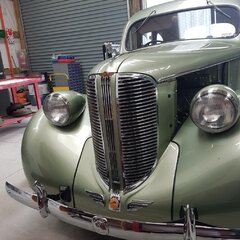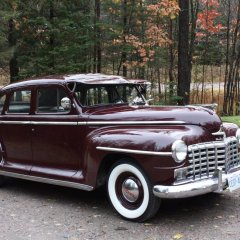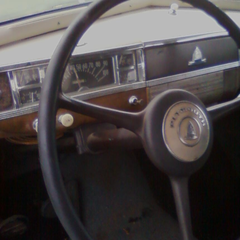-
Posts
694 -
Joined
-
Last visited
-
Days Won
14
Loren last won the day on April 15
Loren had the most liked content!
Reputation
544 ExcellentAbout Loren
- Birthday 10/11/1951
Profile Information
-
Gender
Female
-
Location
Gold Beach, Oregon
-
Interests
All things Internal Combustion
-
My Project Cars
1952 Plymouth Suburban, 1949 Plymouth Business Coupe
Converted
-
Location
Dayton, NV
-
Interests
Antique Cars & Motorcycles
Contact Methods
-
Occupation
Retired
Recent Profile Visitors
The recent visitors block is disabled and is not being shown to other users.
-
My point was that O.D. cars had final drive ratios in the neighborhood of 4.10 ( some places say 4.30 ) and the speedometer pinion that went with it. Thus no matter what gear you were in the speedometer would read incorrectly. Which is true even if that line was unnecessary ( my bad ). All transmissions that have speedometer gears measure the driveshaft rotation speed. Some exceptions are for example VW Beatles measure left front wheel speed and SAAB 99/900 which have the gear on the differential. You can buy speedometers that measure GPS signals and the are dead on with no connection to the wheels or driveshaft but they are really pricey. What I was trying to get across was that you can correct your speedometer reading with an easy swap of the speedometer pinion gear. If you want an O.D. transmission ( R10 G1 ) you can change the speedo pinion with the one in your old transmission. However if you swap differential carriers to get the ratio you want, you need to score the speedo pinion from that car. There is an exception here in that the 3.54 ratio is usually in an automatic transmission car and that speedometer pinion is not the same design as the manual transmission. Slight changes in tire size can get you closer as well.
-
I have an admittedly tight focus on the KT Keller cars, so that's what I research and play with. It's all about having fun after all and those are the ones I like. I am a huge fan of Overdrive transmissions because they don't really change the charm of the cars and actually add to it. When you put one in your car your speedo will be off at all speeds because the speedometer pinion gear was selected for a 4.1 ring and pinion. The good news is you can swap out the pinion from your old three speed to the O.D. and all will be back to normal ( assuming your speedometer doesn't need service ). But what if you changed the rear end ratio or the tire size? I don't advocate changing rear axles because I don't see much to be gained there. You can easily change the differential carrier ( aka 3rd member ) in a Plymouth if you want another ratio. Where I live there's lots of open road with highway speeds of 55 to 70 so optional ratios, tires and O.D. go well with my Plymouth. My P17 Coupe came with 6.40-15 tires ( modern equivalent 195/75/15 ) and a 3.73 final drive ratio so the speedometer pinion would be a 17 tooth gear ( p/n 652-848 ) for an example. Chrysler designed the pinions to use the same 6 tooth gear on the output shaft so you only need to change one gear to correct the speedometer. One thing you find out right away is selecting speedo gears is not an exact science. You can get close and you might hit it right on the button but you more likely will be over or under by 2 or 3 mph. That's why the Highway Patrol has an enforcement tolerance. So let's look at tires first 6.40 15 = 195/75/15 standard tire for a P17 6.70 15 = 205/75/15 standard tire for a P18 7.60 15 = 225/75/15 an optional size tire Final drive ratios 3.90 very common on long wheelbase cars 3.73 standard ratio on many optional on all 3.54 optional Chart of ratios & tires vs speedometer pinions 3.90 6.70 15 17 tooth pinion 3.73 6.40 15 17 tooth pinion 3.73 6.70 15 16 tooth pinion 3.54 6.70 15 16 tooth pinion All 7.60 15 16 tooth pinion So you can see you're not going to get an exact reading but you can get close enough to avoid a ticket. The part number for the 16 tooth pinion is 652-846. I have found that if you have the number for an obscure part the parts house will look to find it in their inventory but they are likely to blow you off if you just say "I need a 16 tooth speedometer gear." Happy hunting!
-
My 49 has only 38,000 miles and steers pretty good without much wandering and I'd like to keep it that way. I have added oil to it and have determined that the seal leaks. Not unexpected for a 75 year old car. One of the benefits of the KT Keller era of cars is that they use a lot of off the shelf bearings and seals. My NAPA store found the seal CR Seals/SKF ( formerly known as Chicago Rawhide ) #12350 or MoPar 639-837 To get to the seal you pull off the pitman arm and I did this with a cheap Harbor Freight puller. It's a spline so all you have to over come is dirt and rust. The generator can be pushed out of the way to withdraw the sector and cap out of the top. As usual there's two ways to do everything of course and I tend to get it right after trying every other possible way. The top cover doesn't come off the sector until you back off the adjustment screw. My M.O. is to get the sector and the attached cover to the bench and then count the turns of the adjustment screw until they part company. I used 5 turns because it was easy to remember. The idea being if you put it back the way the factory had it, you have a better starting point than if you are guessing. ( especially with the steering gear in the car ) The next thing to do is to check the tapered bearings on the steering shaft. The manual says to push/pull on the steering wheel to detect any slop. I could feel a tiny amount so I took the bottom cover off the gear housing. As luck would have it one of the shim/gaskets popped up while the rest stayed put. The factory put a dimple in the frame to enable you to move the cover down a little but you can't take it off without unbolting the gear from the frame. So I snipped the gasket and bolted the cover back on. The up & down movement of the steering wheel was 2/3 less and the turning effort had not increased. All good signs and time to stop. The shim/gaskets are made in several thicknesses and this was a thin one. In my humble opinion, this is the most important adjustment because even a little up & down slop here moves the sector a lot. You can change the sector engagement with the worm till it's so tight you can hardly turn the steering wheel and the sector will still move if the bearings are not right. Now the problem becomes finding another gasket for the top cover. AMSNOS.com had MoPar 1142-262 for around $8 and when I called they had 15 in stock. ( 706 ) 337-4606 The plan is to put the top cover on the sector, turn the adjustment screw 5 turns and slip it back together with the new gasket. Since I detected no wear on any of the parts it should be very close to okie dokie and it won't leak.
- 1 reply
-
- 7
-

-

-
Harbor Freight sells every thing you might need for sand blasting but.... they don't have any compressors capable of keeping up with their blast cabinets or Sand Blasting pots. Also note that sand blasting equipment wears out FAST so there's no need to pay up for better equipment. When I lived in high desert Nevada my Curtis 5 hp Master line compressor did just fine. However, once I moved to coastal Oregon the humidity became a problem. About a sack and a half of sand is all I can blast as water in the air plugs up the sand feed. I have to let the compressor cool off and drain it. For the bead blast cabinet I use 3/8 hose, for the sand blast pot I use 1/2 hose. The HF cabinet has crappy lighting and zero dust collection. You have to add their cheap plastic "cyclone" dust collector on a 5 gallon bucket AND their dust filter/vacuum. You'll find yourself at the glass shop getting new windows made from time to time and the gloves wear out too. SO bottom line: A quality 5 hp 80/120 gallon compressor helps get the job done. Harbor Freight can supply the rest. Like most of the HF stuff you might need to add some features to make it easy to use.
-
It kind of looks like the shifter bushing my 49 has. I wrote in about it a couple of years ago. My shifter was getting stiffer and stiffer and hard to shift. Pulled the whole thing apart looking for the problem. Turns out the “bushing” is a piece of webbing and it had dried out. So I lubed it up and it has worked fine ever since. Your steering shaft bushing looks very much like my shifter bushing. If you oil it, it might swell up and work fine. Lastly if your steering wheel moves up and down when you pull on it, you need to adjust the steering gear bearings. The seal in mine leaks so that’s a job I have to do as well. I’ve been through the shop manual prepping to do it. I have the front sheet metal off right now ( a rust prevention project ) so I can get good photos for a write up coming soon.
-
The gasket set and the seal work for OD and STD transmission. That is one of the beauties of the R10 G1 Overdrive.
-
From my view point it's a Hudson Hornet with twin H-Power intake manifold and two Graham/Kaiser centrifugal superchargers. Not sure how the carburetors work in the blow through configuration ( The Graham/Kaiser supercharger was made for suck through carbs mounted on the blower itself ). In the Graham/Kaiser they used the Continental 225 6 cylinder that could be found in forklifts ( and other cars ) that didn't have Chrysler engines. I am guessing the blower was driven from the camshaft side using the gear driven cam where the hydraulic pump was in a forklift. Here's a photo showing the Chrysler version of the cam drive. Of course that requires a reverse rotation cam and a different oil pump gear. Back in the early 1960s you could buy those blowers at swap meets for $5. lol But then that was a lot of money.
-

Optional Gear Ratio for 3 speed or Overdrive Transmission
Loren replied to Loren's topic in P15-D24 Forum
All ready to re-install. I bought this one on eBay for $400 delivered. When I changed the Counter Shaft Gear ( aka Cluster gear ) I didn't like the countershaft so I replaced it with a good used one. The reverse lock out switch was open so I replaced that as well. Other than those items it was in very good shape. If you are going to go through one of these, the service manual and a parts book will help. There's a couple of little secrets you have to know about. Example: the lockout arm must be retracted to take the back housing off and there is this tiny tapered pin you have to drive out with a pin punch to do that. If the transmission is covered in grease you may not find it. I got all my parts super clean and checked the movement and function at each stage of assembly. I did not however install the governor as the book says to do. When I rolled the transmission over on the bench the pawl slid into place and things wouldn't turn as expected. I took it apart once more and figured out what had happened. Not a bad thing as I am now really good at assembly and disassembly for the experience. lol Of course it happened again and I simply turned it over and the pawl slid back into its rest position. Since my Suburban has Back Up Lights I wanted to see if I could add the switch with the Overdrive. It does fit and it does work! The beauty of the B-W R10 G1 Overdrive is all the MoPar replacement parts fit. Most of the wear parts in the Overdrive unit are standard B-W parts common to the other makes that used it. The reverse lock out switch is different however. When you see them on eBay most sellers call them a "Neutral safety switch" because that is what they look like. If p/n 1370-462 ever becomes hard to find at a decent price an adaptor could be made to fit a "real" neutral safety switch. ( another note: there's a short little round part that relays the movement of the reverse shift shaft to the switch. If you remove the switch under the car it will fall out and you could lose it. Best to check it before you install the transmission ) -
Powerflyte 2 speed automatic?
-
I just finished putting my Overdrive back together. So this is fresh in my mind. 1) The Best Gasket Company gasket sets do not include the seal washers for the bolts on the main shaft bearing retainer ( where the throw out bearing is mounted ) 2) That same part sometimes requires more than one gasket to seal. ( because of variations in the bearings ) 3) There’s plug that fits in the end of the 2nd & high shift shaft. ( but not the first & reverse and I can’t tell you why ) 4) The counter shaft could be a source of leakage. I used some low strength Locktite for pre-assembled parts on it, then a dab of Permatex Right Stuff gasket sealer. ( the idea of using a penny as a plug is one I will investigate before installation ) 5) There’s gasket between the bell housing and the transmission. So there’s some ideas as a source of leaks.
-

Optional Gear Ratio for 3 speed or Overdrive Transmission
Loren replied to Loren's topic in P15-D24 Forum
Thank you for the charts! I have had a couple of vehicles with Overdrives in them. I personally think the flathead Plymouth benefits the most from them. There is a certain charm about a flathead Plymouth and the Overdrive transmission only adds to it. The governor does exactly what it’s name implies, its in control. The only gear that is really locked out is reverse. You can’t use Overdrive in first gear because you can’t windup the engine far enough to trigger the governor. Second gear isn’t that easy to trigger either. I’ve done it but its not easy and you’d probably select high gear anyway rather than bother. The governor measures drive shaft speed and not road speed and most of us are not going back to a 4.30 final drive ratio like the factory supplied in Overdrive cars. So in truth you’d likely never use 2nd gear Overdrive. The drive shaft speed vs road speed will vary with the final drive ratio you have of course, so the governor trigger speed is going to be higher with a 3.73 vs 4.30 final drive ratio. When you consider the weight of a flathead Plymouth and the fact that its being pushed along with around 100 hp, they do pretty good! I read a road test of one and it managed a quarter mile in 22 seconds, about the same as a Porsche 924! So they are in good company ( even if there are more flathead Plymouths running around now than Porsche 924s lol ) -
The benefits of a diaphragm pressure plate are reduced pedal pressure and increased gripping strength. An added bonus is when it reaches its end of life, the pedal pressure goes up noticeably. However you might need two similarly equipped vehicles to detect the change because it takes place over such a long time. When you see a lot of cars with diaphragm clutches you can tell the one that needs a clutch with one press on the pedal. Just as with a spring clutch they will slip if you don’t adjust them as they wear.
-
Here’s my two cents: 1) The Chinese throw out bearings from AB are noisy. 2) Get that flywheel machined ( you were probably going to do that anyway ) 3) Have your pressure plate, clutch disc and flywheel rebuilt by a local “Friction Materials” shop and get an American T.O. Bearing from them Anything that does not require a core is Chinese made. Suppliers love not dealing with cores and buying at low prices. I am not saying you can’t get really high quality Chinese stuff, but not many outfits sell it and you will have to pay more for it. ( remember they have the bomb so they know how to make high quality stuff ) I think you will find rebuilders that can save you some money and give you great quality. 4) Lastly if you want to you can put a 10 inch clutch in your car. That’s what the Taxis had.
-
There's an old joke told by Rodney Dangerfield about dinner at his house. "You don't brush your teeth after dinner, you count them!" Well, I am going through an Overdrive transmission and I decide to try the only optional gear set for the 1940-54 transmission. At the same time I am building a 1939 Ford V8 transmission and a Studebaker R10 Overdrive ( very old school, mounted in the middle of the torque tube ) to replace the hated T5 in my Model A. My Dad said he had a set of Lincoln Zephyr gears and I thought I try them at the same time. Well a Lincoln Zephyr gear set is 3 gears and if you want a NOS set they are astronomical in price! ( there's a set like I thought I had for $2,895 on eBay ) Turns out what I had was two of the correct gears and a cluster for a 1955-56 Ford with a 272 V8. When I looked at a gear chart from Van Pelt Sales and counted the teeth nothing made sense. Hence the Rodney Dangerfield joke. It took a phone call to Mac Van Pelt to identify what I had. Back to the Plymouth: At the time my cars were built ( 1949 & 52 ) the speed limit was 55 mph and the closest thing to a freeway in Los Angeles was the Arroyo Seco Parkway ( aka Pasadena Freeway ). Which is kind of laughable as a "Freeway". Anyway that's why the old cars had 3.90 rear ends and 3 speed transmissions. When Chrysler went to column shift ( largely so a 5 passenger car could suddenly become a 6 passenger car ) They tried the one year only second gear ratio and thought better of it for 1941. Turns out that 1940 second gear ratio was highly regarded with the "Boy Racers", it making the mopar gear box more close ratio. Not only were there lots of factory gears sold as replacement parts, the after market made them too. There's plenty of them for sale on eBay for less than $300! That seemed to me like a cheap experiment. So here we go counting teeth again. The 1940 Cluster Gear ( aka Transmission Countershaft Gear ) is part number 853-885 and has the tooth count of 32-25-19-14 Whereas the 1941-54 tooth count is 32-23-19-14. Second gear is the only different ratio and thus you only have to change two gears. The 1940 second gear is part number 692-687 and it's tooth count is 23. The 1941-54 second gear tooth count is 25. Enter the Overdrive: The Plymouth R10-G1 Overdrive will shift into 2nd Overdrive plus the top gear overdrive making it actually a 5 speed. When new, the cars were delivered with 4.30 rear end gears giving them lively acceleration....to 55 mph. Now days as the song says "I can't drive 55!" My 49 came with a 3.73 rear end and with Overdrive that car is really happy at 55 mph and 70 sounds like 55 used to. When I installed the Overdrive I swapped the speedo gear from my old transmission which has 17 teeth and the speedo is close ( p/n 652-848 ). With a tire size change and I would change to a 16 tooth speedo gear P/N 652-846 which is also useful with a 3.54 rear end ratio ( there being no other smaller tooth count speedo gears ). One fly in the ointment: Between the loose needles used in the cluster gear and the thrust washers it's a challenge to assemble the countershaft. Chrysler had a solution for the dealer mechanics, the Miller Special Tools C-578. It is a short rod slightly smaller in diameter than the countershaft and only as long as the cluster gear with the thrust washers. You assemble the cluster gear with grease ( to hold the needles and washers ) with the tool inside. After all the other parts are installed you invert the case and the cluster falls into place. Then you push the counter shaft in and the tool keeps everything aligned until the counter shaft is in place. The same method is used by locksmiths changing the pin combinations. Only one problem, try and find one! SO...I am going to make some from plastic rod stock which will work even better than the metal one did. If you enjoy using your brain and working little issues out, the old car hobby is the best! Have fun!
-
I have a 49 Business Coupe and I retained the vacuum wipers but added a dual chamber fuel pump. The top section produces vacuum at the moment you need it when pressing down on the gas pedal. Most electric wipers require 12 volts and have two speeds. The vacuum wipers have infinite speeds. Since I plan to keep the 6 volt system this was my old time solution.




.thumb.jpeg.28cb36506a6b17cd30e7d4a22504384d.jpeg)



